Imagine a global marketplace that never truly sleeps. That’s the Forex market for you, a dynamic, 24/5 arena where currencies are exchanged around the clock. But just because it’s always open doesn’t mean it’s always buzzing.
As a new trader, one of the first questions you might ask is: “When is the best time to trade?” The answer lies in understanding the core structure of this global market.
So, let’s get straight to the heart of it – the question every new trader asks: what are the 4 trading sessions? Forget just listing open and close times. We’re diving into the unique personality of each session and showing you how to turn this knowledge into a sharper, more effective trading strategy.
Key takeaways:
- Global 24/5 market: The Forex market operates 24 hours a day, five days a week, driven by four major trading sessions: Sydney, Tokyo, London, and New York, each with distinct hours and characteristics.
- Session characteristics: Sydney is calm with lower volatility, Tokyo offers range-trading opportunities, London is the most liquid and volatile, and New York drives strong trends, especially during its overlap with London.
- Overlap opportunities: The London-New York overlap (8 AM–12 PM ET) is the most active period, offering high liquidity and volatility, ideal for day traders and scalpers.
- Risk management: Allocate daily risk across sessions, adjust position sizes for volatility, and consider stopping trading after hitting session loss limits to maintain discipline.
- Strategic trading: Align your trading style (scalping, swing trading) with session activity, choose currency pairs active in specific sessions, and stay mindful of economic news releases and Daylight Saving Time shifts.
1. Understanding the global nature of Forex trading sessions
The Forex market stands out because it operates 24 hours a day, five days a week. Unlike stock markets with specific opening and closing bells, currency trading happens continuously. This constant activity is possible because the market is decentralized, meaning there’s no single physical exchange.

Instead, trading flows seamlessly from one major financial hub to another as local business hours begin and end. This global participation from banks, institutions, and individual traders across different time zones ensures the market is always moving. However, not all hours are equally active.
Understanding these Forex trading sessions is key for any trader. It helps you recognize when different parts of the world are most engaged, which directly impacts two key factors: market liquidity, meaning how easily you can buy and sell, and volatility, which is how much the prices can swing.
For new traders, knowing these sessions isn’t just about market hours; it’s about smart trading. It helps you manage your time effectively, pinpoint periods of higher opportunity, and reduce the risks associated with trading during low-liquidity phases when spreads might widen.
View more: Financial terms every beginner should know
2. What are the 4 trading sessions? A detailed breakdown
While trading occurs continuously, the market’s pulse quickens and slows based on the business hours of the world’s largest financial centers. These are primarily grouped into what are the 4 trading sessions that define the Forex trading day. Each session brings its own unique characteristics, influencing currency pair movements and trading opportunities.
2.1. The Sydney session (The opening bell of the week)
The Sydney session officially kicks off the trading week. For traders in the United States, this is the first session to open late Sunday afternoon.
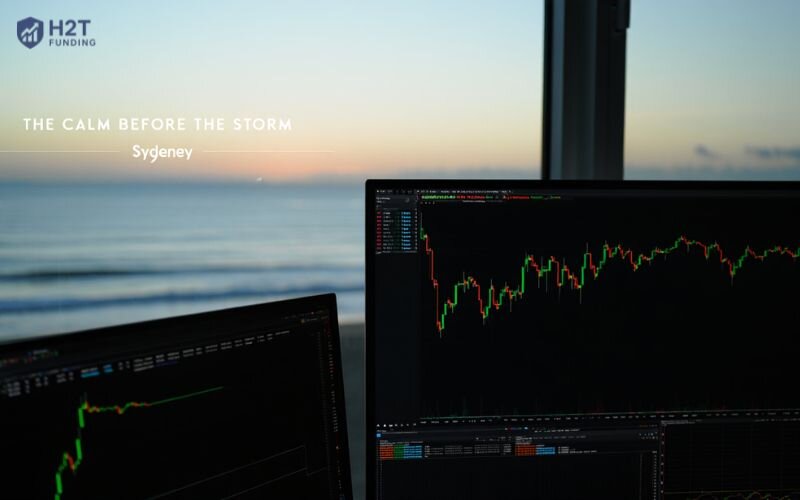
Typical hours:
- Eastern Time (ET): 5 PM – 2 AM (Sunday to Monday).
- GMT: 10 PM Sunday – 7 AM Monday (adjusts with DST).
Note: These times can shift by an hour for those outside the US, as Australia observes its own Daylight Saving schedule, but the ET hours are a reliable benchmark for US traders.
- Key characteristics: Think of the Sydney session as the calm before the storm. Liquidity is generally thinner than in London or New York, so this isn’t the time for hunting massive breakouts. Instead, it gently wakes the market up after the weekend and often gives us the first clues about the week’s trading sentiment. Naturally, pairs like AUD/USD and NZD/USD are the main event here.
- Trading considerations for beginners: Due to its relatively lower volatility, the Sydney session might be suitable for traders who prefer less dramatic price swings or those looking to place longer-term positions.
View more: Best trading strategy for beginners
2.2. The Tokyo session (The Asian powerhouse)
Following Sydney, the Tokyo session takes over as the main financial hub in Asia. This session overlaps significantly with the Sydney session.

Typical hours:
- Eastern Time (ET): 7 PM – 4 AM.
- GMT: 12 AM – 9 AM.
Note: Japan does not observe Daylight Saving Time, so its hours relative to GMT are consistent year-round.
- Key characteristics: While more liquid than Sydney, the Tokyo session generally exhibits lower volatility compared to the later European and North American sessions. Currency pairs like USD/JPY, EUR/JPY, and AUD/JPY are typically quite active. News and economic data releases from Japan, China, and Australia can significantly influence market movements during this time.
- Trading considerations for beginners: If you’re a fan of range-trading strategies, the Tokyo session might be your new best friend. Major pairs often tend to settle into a predictable channel during these hours, creating opportunities to buy at the bottom and sell at the top of a range, rather than chasing massive trends.
2.3. The London session (The European hub & most active)
The London session is the largest and most liquid Forex market in the world. For US traders, it starts in the early morning hours and sets the tone for the day before New York even opens.

View more: How to pass FTMO Challenge
Typical hours:
- Eastern Time (ET): 3 AM – 12 PM (noon).
- GMT: 8 AM – 5 PM (adjusts with DST).
- Key characteristics: This session experiences the highest liquidity and volatility among all the major sessions. It significantly overlaps with both the Tokyo and New York sessions, leading to heightened market activity. Nearly all major currency pairs like EUR/USD, GBP/USD, USD/CHF, and EUR/GBP are highly active. This period is also packed with numerous economic news releases from Europe.
- Trading considerations for beginners: The London session offers substantial opportunities due to large price movements, but it also carries higher risk due to increased volatility.
Here’s a hard-learned lesson: nothing will teach you the importance of a stop-loss faster than a sharp, unexpected move during the London session. During these dynamic hours, risk management isn’t just a good idea, it’s the one thing that will protect your account.
Understanding what is leverage in trading can help you navigate the high volatility of the London session effectively.
2.4. The New York session (The North American giant)
The New York session is the home session for US traders and the dominant financial center for North America. It marks the final hours of the global trading day.

Typical hours:
- Eastern Time (ET): 8 AM – 5 PM.
- GMT: 1 PM – 10 PM (adjusts with DST).
- Key characteristics: This session boasts high liquidity, especially during its overlap with the London session. It’s heavily influenced by economic data and news releases from the United States. USD-centric pairs like EUR/USD, GBP/USD, USD/CAD, and USD/JPY are typically very active as North American traders enter the market.
- Trading considerations for beginners: The New York session is excellent for trend-following strategies due to its strong directional movements, particularly in the first few hours. However, as with London, the volatility can be high, so maintaining a disciplined risk management approach is crucial.
View more: What is leverage in trading?
3. The power of overlaps: When two markets collide
Knowing the 4 sessions is a great start, but here’s where the real action begins. The true magic in the Forex market happens during those key hours when two major markets are open for business at the same time.
These periods are known as session overlaps, and they are crucial for traders seeking increased opportunities.
When two financial centers are active at the same time, it naturally leads to a surge in market participation. This results in significantly increased liquidity, meaning more buyers and sellers are present, making it easier to enter and exit trades.
Higher liquidity often translates to tighter spreads and better execution. More importantly, these overlaps typically bring about higher volatility, leading to larger price movements and potential for greater profits, though, of course, also greater risks.

Let’s look at the key overlap periods that every Forex trader should be aware of:
- London-New York overlap (Most significant):
- Hours: 8 AM – 12 PM (noon) ET.
- Why it’s crucial: This is the most important overlap. With the world’s two largest financial centers open, this period has the highest liquidity and volatility, offering significant trading opportunities.
- Pairs: EUR/USD, GBP/USD, USD/CHF, and many other major currency crosses tend to be extremely active.
- Tokyo-London overlap:
- Hours: 3 AM – 4 AM ET.
- Impact: This brief one-hour window sees a spike in activity as London traders come online, often extending or reversing moves that started in the Tokyo session.
- Pairs: You’ll often see increased movement in EUR/JPY and GBP/JPY as European traders join the flows originating from Asia.
- Sydney-Tokyo overlap:
- Hours: 7 PM – 2 AM ET.
- Impact: This is the main overlap for the Asia-Pacific region, providing good liquidity for pairs like AUD/JPY and NZD/JPY during the US evening hours.
- Pairs: AUD/JPY and NZD/JPY are examples of pairs that might show increased activity during these hours.
View more: How to choose a prop firm
4. Risk Management in Multiple Sessions
For traders who operate across different global trading sessions, such as the Asian, London, and New York sessions an additional layer of risk management is required. To illustrate this, consider the risk management approach used by proprietary trading firms (prop firms).
For example, a firm like FTMO applies its fixed loss limits over a continuous 24-hour period, not on a per-session basis.
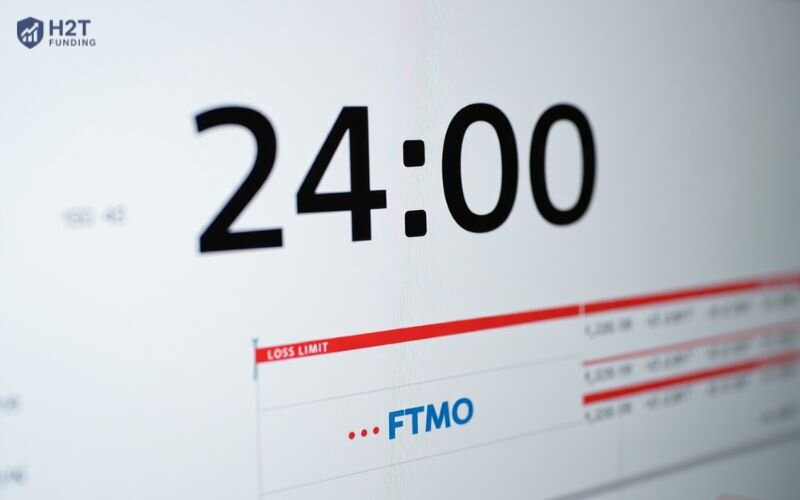
Their Maximum Daily Loss limit is not reset with each new trading session; it is a hard limit calculated over a full 24-hour cycle. This principle highlights that a loss incurred during the Asian session directly reduces your available risk buffer for the subsequent London and New York sessions on the same day.
Here are some strategies to manage this effectively:
- Budget Your Daily Risk by Session: A disciplined approach is to mentally or formally allocate your 5% daily loss limit across the sessions you intend to trade. For example, you might decide to risk no more than 1.5% during the Asian session, 2% during the London session, and 1.5% during the New York session. This prevents a single poor session from jeopardizing your entire trading day and violating the daily loss rule.
- Implement a “Hit and Stop” Rule per Session: A more conservative tactic is to cease trading for the day if you hit your predefined loss limit for a specific session. For instance, if you lose your allocated 1.5% during the Asian session, you do not proceed to trade the London open. This instills immense discipline and prevents the emotional urge to “revenge trade” in the next session to recover losses.
- Adjust Position Sizing to Session Volatility: Recognize that different sessions carry different levels of volatility. You might use smaller position sizes during the typically calmer Asian session and reserve your larger risk allowance for the more liquid and volatile London/New York overlap. This aligns your risk exposure with market opportunities.
When managing multiple accounts, this principle becomes even more critical. A significant drawdown on one account during a specific session should serve as an immediate signal to review and possibly reduce your exposure across all other accounts for the remainder of the day.
The goal is to prevent a single bad period from causing a cascade of breaches across your entire capital base. This kind of effective, session-based risk management is ultimately what separates a professional, sustainable trading approach from the rest.
5. Practical tips for trading around Forex sessions
Understanding what the 4 trading sessions and their overlaps are more than just knowing times; it’s about applying that knowledge to refine your trading approach. Here are some practical tips to help you leverage market hours effectively.
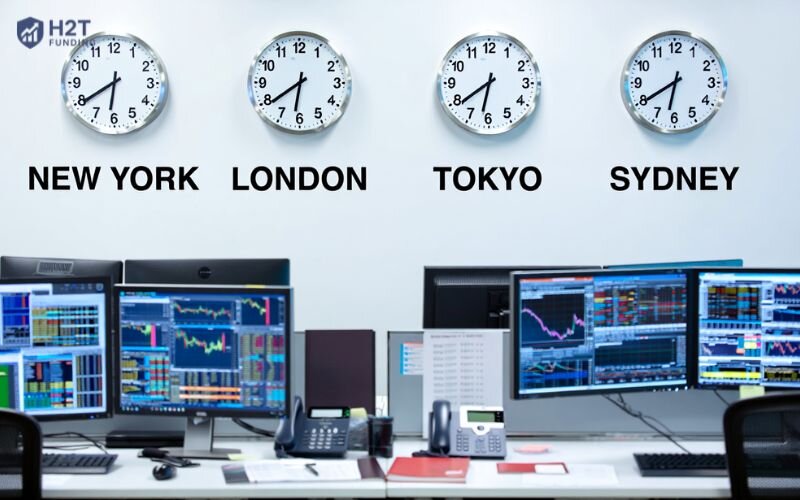
Aligning with your strategy: Your trading style should ideally match the market’s activity.
- Scalpers and day traders: These traders often thrive on high volatility and liquidity, making the major session overlaps (especially London-New York) prime opportunities.
- Swing traders: You might find suitable entry or exit points in quieter sessions, or focus on the less intense periods within the more active sessions, patiently waiting for larger trends to develop.
Choosing the right currency pairs: Maximize your potential by trading pairs where both currencies’ home markets are actively open. For instance, EUR/USD often sees its strongest movements during the London-New York overlap, as traders from both regions are engaging.
Importance of economic news releases: Scheduled economic data releases (like Non-Farm Payrolls, interest rate decisions, or CPI reports) can drastically impact volatility regardless of the session. However, their effects are amplified when released during major trading sessions, especially during overlaps, as more participants react instantly. Always check an economic calendar.
Risk management: Higher volatility during active sessions and overlaps means the potential for greater profits, but also greater losses. It’s crucial to implement robust risk management strategies. This includes setting clear stop-loss orders to limit potential downsides and sizing your positions appropriately for the expected market moves.
A note on Daylight Saving Time (DST) for traders: While using Eastern Time (ET) as a benchmark is convenient, it’s crucial to be aware of Daylight Saving Time shifts. The United States, Europe, and Australia adjust their clocks on different dates. This means the start times of the London and Sydney sessions, when viewed in ET, will shift.
For instance, the London open can move from 3 AM ET to 2 AM ET depending on the time of year. Relying on memory is risky; therefore, always use a real-time market clock tool to confirm the exact session hours.
6. Beyond the basics: Advanced considerations for understanding market flow
Beyond simply knowing what the 4 trading sessions are, a deeper understanding of market flow involves recognizing the subtle nuances that influence activity throughout the 24-hour cycle. This can help refine your trading plan even further.
6.1. The quiet hours
The period with the lowest liquidity typically occurs after the New York session closes and before the Tokyo session gains full momentum. This window, roughly between 5 PM and 7 PM ET, is when the Sydney session operates alone.
During these “quiet hours,” market participation is thin, spreads can widen significantly, and price action may be erratic or choppy. It is generally wise for most traders to avoid initiating new positions during this low-activity period.
6.2. Weekends and holidays
While the Forex market operates 24/5, it does close on weekends, from Friday evening (when the New York session ends) until Sunday evening (when the Sydney session begins).
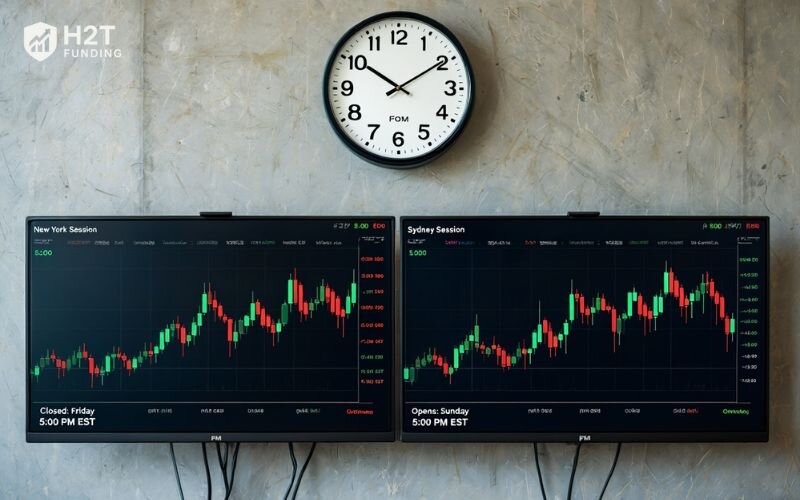
Additionally, major global holidays (like Christmas Day and New Year’s Day) see the market either close entirely or operate with extremely low liquidity. Planning around these closures is essential to avoid being caught by unexpected gaps when the market reopens.
6.3. The psychological aspect
The market often behaves like a global relay race. A strong trend started in Tokyo might get the baton passed to London traders, who push it even further. But sometimes, when New York enters, they might start running in the opposite direction, creating a massive tug-of-war. Instead of just looking at the chart, ask yourself: ‘What story is being told as the session baton is passed?’
6.4. Leveraging Forex market time tools
While understanding the concepts is vital, practically tracking the exact opening and closing times across different time zones, especially with Daylight Saving Time shifts, can be tricky.
Many reputable Forex resources offer real-time market hour tools that automatically convert session times to your local time zone. Utilizing these can remove guesswork and ensure you’re always aligned with the active periods.
Discover related blog posts in this section:
7. FAQs
The four primary Forex trading sessions, listed in Eastern Time (ET), are: Sydney Session: 5 PM – 2 AM ET (starts on Sunday) Tokyo Session: 7 PM – 4 AM ET London Session: 3 AM – 12 PM (noon) ET New York Session: 8 AM – 5 PM ET
The “best” time depends on your strategy, but the London-New York session overlap (8 AM to 12 PM ET) is generally considered the most active. This four-hour window offers the highest liquidity and volatility, making it popular for day traders and scalpers seeking significant price movements.
Yes, the Forex market does close on weekends. It typically shuts down on Friday evening (when the New York session concludes) and reopens on Sunday evening (when the Sydney session begins). The market also observes closures on major global holidays like Christmas Day and New Year’s Day.
The best pairs for the London session are the “majors” because of high liquidity and tight spreads. These include: EUR/USD GBP/USD USD/CHF USD/JPY Pairs involving the British Pound (GBP) and Euro (EUR) are especially active. For traders seeking higher volatility, Yen crosses like GBP/JPY and EUR/JPY are also popular choices during this time.
During the Asian (Tokyo) session, pairs involving the Japanese Yen (JPY), Australian Dollar (AUD), and New Zealand Dollar (NZD) are the most active. The best pairs to focus on are: USD/JPY AUD/USD NZD/USD Yen crosses like AUD/JPY and NZD/JPY These pairs have higher liquidity and are more influenced by economic news released from Japan, Australia, and China during these hours.
The overlap between the London and New York sessions is widely considered the best time for a day trader. This period, typically from 8 AM to 12 PM EST (1 PM to 4 PM GMT), offers the highest liquidity and volatility, creating more trading opportunities. The London session by itself is also excellent for day traders due to its high volume and significant price movements.
8. Conclusion
Mastering the answer to “what are the 4 trading sessions?” is more than just learning theory; it’s about gaining a strategic edge in the market. It empowers you to stop trading blindly and start aligning your strategy with the market’s natural rhythm.
At H2T Funding, we’re committed to building traders who think professionally. This foundational knowledge is the first step. When you’re ready to see how professional traders apply these timing concepts with advanced techniques, our “Prop Firm & Trading Strategies” section is your next destination. That’s where timing meets technique and where real Strategies are forged.

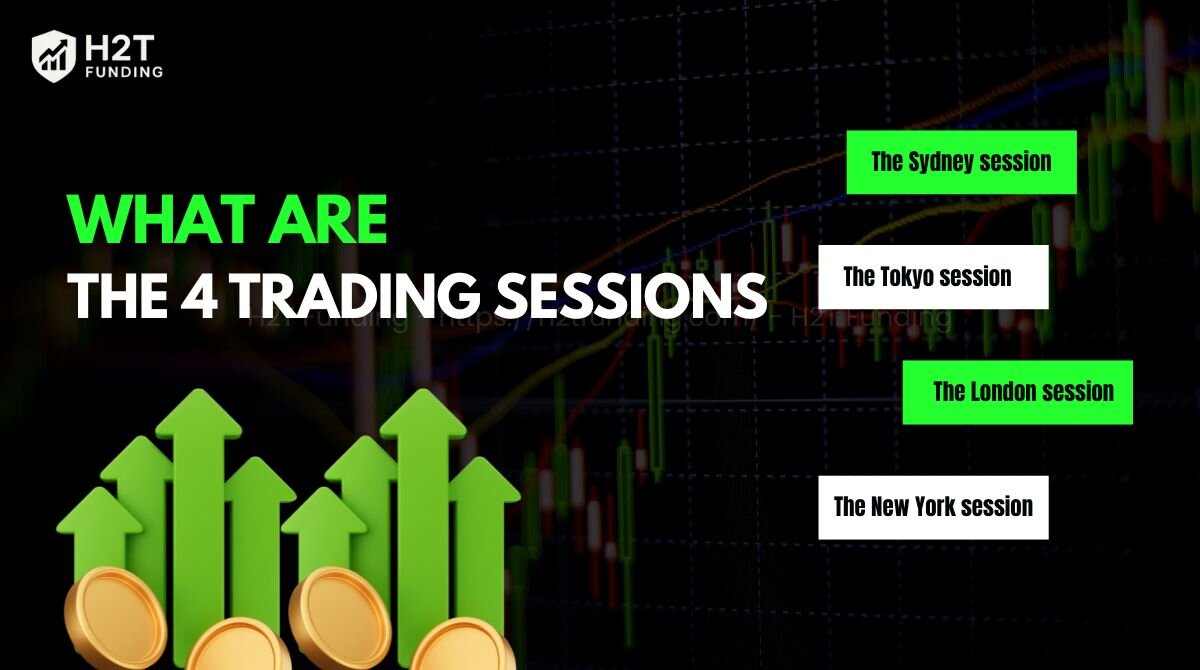


![Topstep Trades Closed By What Time [New Updated Guide]](https://cdn.h2tfunding.com/wp-content/uploads/Topstep-Trades-Closed-By-What-Time-New-Updated-Guide-768x429.jpg)
